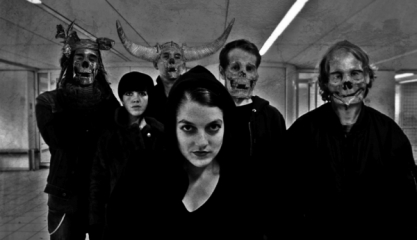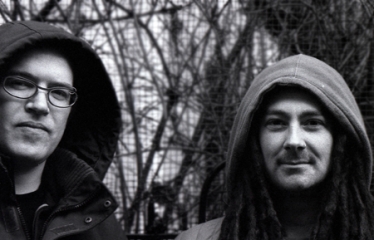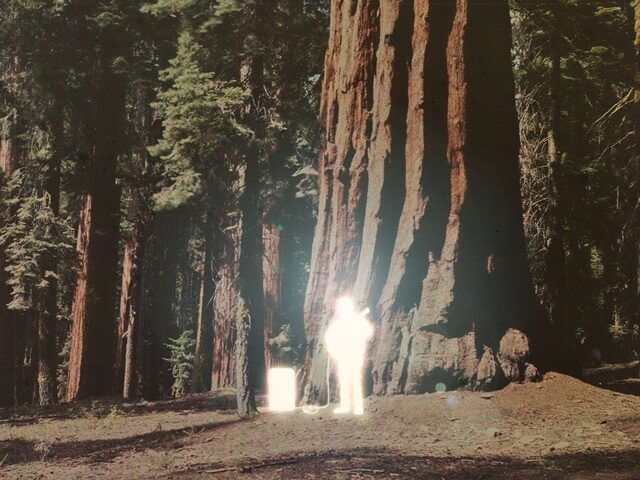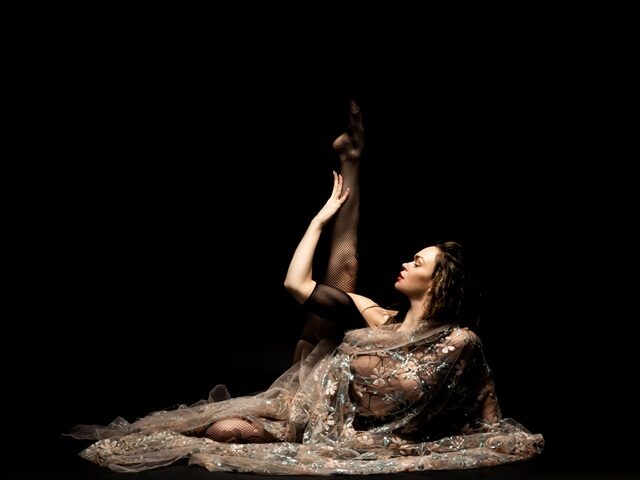
When projects attempt to be conceptual in both their style and purpose, there arises a sensitive area where criticism has difficulty retreating from the subjective to the objective. What we define as “quality” is premeditated by our own personal taste and is primarily subjective, but a release can also reach a consensus of inarguable quality and influence that gravitates more toward the objective. This almost always occurs quite some time after the initial release, for the term “instant-classic” is rarely used properly and often exaggerated when done so. If you wish to listen to The Kilimanjaro Darkjazz Ensemble, you are probably going to have to leave any of these subjective perceptions of quality at the door. You cannot compare anything definitive to this project, another brainchild of the ceaselessly active and multifarious Jason Köhnen. He is best known for Bong-Ra, another project of his since 1996 that has emerged as one of the most respectable sources of quality breakcore, which is basically a fancy name for industrialized techno with heavy percussion and samples at high tempos. Most of his projects possess these obnoxiously non-descriptive names like breakcore, but he is obviously not to blame. In fact, when you are as constantly innovative as Köhnen, listeners have no choice but to make up sub-genres in order to express what tickles their fancy.
It is always easy to cover an artist that fits generic words like “breezy indie-pop” or “tender acoustics”, but when using these terms without further clarification it tends to be an indicative of lacking originality. Perhaps this is why I am lost when attempting to concisely describe The Kilimanjaro Darkjazz Ensemble, as their swirling assortment of influences and stylistic directions allow the listener to take a full-bodied ride into unchartered territory with touches of jazz, post-rock, electronica, and IDM without being too overwhelming. The Kilimanjaro Darkjazz Ensemble formed in 2000 out of mutual admiration for silent filmmakers that used powerful music to convey raw emotion in synchronization with visual content, an interesting influence since this concept is often lost in modern film-making for special effects and generic instrumental covers. Notable influences included F.W. Murnau, Fritz Lang , and even somewhat contemporary works by the likes of Jan Švankmajer (check out his 1988 stop-motion interpretation of Alice in Wonderland for some cool stuff). The members of The Kilimanjaro Darkjazz Ensemble were so enthused by the passion of these filmmakers that Köhnen and co. began composing scores to already existent films, arranging soundtracks to the classic likes of Nosferatu and Metropolis in order to hone their experience in the most unique way possible.

As a true pursuer of stylistic ambitiousness, such tactics are hardly a surprise for followers of Köhnen. There is no method or style that seems beyond his reach. Bong-Ra played with everything from dance-rave to avant-garde jazz, a feat that was diverse enough to receive acclaim from the likes of John Peel (who included him as one of the 125 best Peel sessions ever). I admittedly find breakcore to be a frustrating genre, often sounding cluttered due to repetitive tempo or lack of melody altogether, but Köhnen’s work tends to appeal more to the majority despite his distinctively avant-garde leanings. Although his layers may have occasionally been too complex or his ideas overly thematic to grasp, Bong-Ra showcased a variety of genres like hip-hop and jazz that did not abide by breakcore’s very specific classification. In comparison to this, Köhnen’s new foray with The Kilimanjaro Darkjazz Ensemble is more straightforward, but also packs more of an emotional punch than any of his earlier material. Whereas his previous work would have sounded best at a rave party, this work with The Kilimanjaro Darkjazz Ensemble instead sounds like the ambiance of Hades, where contemplative sorrow is displayed more than impulsive excitement. The dramatic alteration in mood is one notable aspect of the transition to Köhnen’s new project, and it is not the only one either.
The stunning parts of The Kilimanjaro Darkjazz Ensemble’s third album, Here Be Dragons, are abundant, but not in the instantaneously infectious sort of way many are used to. Keep in mind that this is the same sort of stuff that World’s End Girlfriend have done so well, where full-blown orchestras combine with jazz percussion to craft audible worlds that are bleak, serene, and chilling. Too in-depth to serve as a film soundtrack, the works of these artists are often overlooked due to the sheer complexity and scope of the project. The beautiful “Embers” is one of the more concise efforts on the album, but it still builds with collapsing thunder as brass, horns, and the ghostly vocals of Charlotte Cegarra evolve into both vocal-led emissions of fury and smoothly presented saxophone solos. The diversity on tracks like these throughout the album is absolutely extraordinary, a true landmark achievement even for an artist as eclectically inclined as Köhnen. “Embers” almost has that sort of ethereal, crystal-y feel to it that is reminiscent of Air’s Moon Safari days, especially in the way Beth Hirsch sent chills up listener’s spines on “All I Need” with her fragile croon. The parallel between the somber and free-fleeting moments of “Embers” are the best parts; the brass solos and detached vocal additions are juggled masterfully.
It would be acceptable if the rest of the album sounded like “Embers”, but any fans of the Utrecht-based Köhnen know that it is his tendency to mix things up. “Sirocco” is an amiable effort with the initial giddiness of Afro-pop keys making one of those oh-so-brilliant Köhnen mood transitions. Cegarra’s vocals appear alongside the strings, which sound very thick and reverb-heavy over a haunting melody that already portrays darker elements on its own. The percussion here is certainly influenced by his earlier works, as the industrial feel is heavily prevalent in both that and the backing atmospheric pads. “Mists of Krakatoa”, while lacking the general passion of the other two tracks, is exceptional for its sheer curiosity in blending Cegarra’s operatically inclined vocals again with strings, except unlike in “Sirocco” they collide here with a piano in minor key and the backing whirring of what faintly sounds like machines at work. This is less structurally cohesive than the others, like the fantastic opener “Lead Squid” or plucked goodness of “Caravan!”, but still retains its value through innovative sophistication and cumulative emotional expression. Some tracks on Here Be Dragons may take too long in their introduction or conclusion, but in their climaxes they will convey a type of innovation and musicianship that stands out even among the avant-garde.
RIYL: World’s End Girlfriend, Portishead, the later and more experimental years of Talk Talk
——————————————————————————————
The Kilimanjaro Darkjazz Ensemble – Embers
[audio:http://mineorecords.com/mp3/kde-emb.mp3]——————————————————————————————
The Kilimanjaro Darkjazz Ensemble – Sirocco
[audio:http://mineorecords.com/mp3/kde-sir.mp3]——————————————————————————————
The Kilimanjaro Darkjazz Ensemble – Mists of Krakatoa
[audio:http://mineorecords.com/mp3/kde-mis.mp3]——————————————————————————————






I’m surprised you didn’t say this … but sounds like a jazzier version of Portishead with that “Embers” track. Heck, the name of the track even sounds like a Portishead song. I will certainly keep watch for more form this band. Interesting sound.
good observation, I can definitely see what you mean. that comparison escaped me but I’m going to add Portishead to the RIYL tag. they also served as one of the precursors to this form of electronica we see abundant today.
The style of the vocals reminded me of Swedish jazz-singer Josefine Cronholm on the soundtrack to the movie Mirrormask. Besides that I haven’t heard anything like it. Thanks!
Oh yes, the moment I heard ‘Embers’, and that voice- I was reminded of Beth Gibbons and Portishead.
Interesting how you rag out on one ‘obnoxiously non-descriptive’ subgenre (breakcore) then use the name of another freely (IDM) later on in the review, I suspect because the later scene is more publicly accessible and so you know what it is. Hundreds of people and thousands of hours of effort haven’t been put into developing a musical style so that people like you who have absolutely no idea what that style is (‘industrialized techno…at high tempos’ breakcore most certainly is not) can then cast it off as being ‘obnoxiously non-descriptive’, just another scene created by twerpy little teens on the internet. Of course there is a limit to what we should classify as a genre, but if that limit serves a studious and organizational, as well as developmental purpose, then it’s a positive thing. It’s like putting your salt and your sugar in the same jar. They look the same on the outside, but stick em in your mouth and you find out they’re different. For many music appreciators these days, lashing out against the genre explosion is simply a rebellion against those who have taken that explosion too far, and both parties are piled onto bandwagons, albeit at opposite ends of the spectrum. The sage thing to do is perhaps properly guide the direction of genres by studying it and having a firm sensibility of what genres are and should be and helping to guide this situation’s undeniable future in the right direction – and all you have to do to help this is have an opinion on it (giving the troublesome child therapy instead of throwing him out onto the street).
Sorry, but I had to defend my breakcore there, as it does actually have a very distinct sound and essence, and when people talk about it like that, it definitely isn’t doing any justice to the wonderful little scene that it is, even if such extreme music isn’t for everyone.
(PS Breakcore is simply hardcore breaks – breakbeats taken to their fastest, most intricate and overwhelming extremes. Breakcore musicians love to mashup genres and use humor, but this is simply part of the style, adding to the characteristic intensity and unhinged experimentalism.)
Os dejo mi reseña, aunque está en español…
http://enclavedelunachao.blogspot.com/2011/07/kilimanjaro-darkjazz-ensamble.html